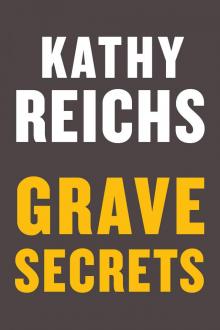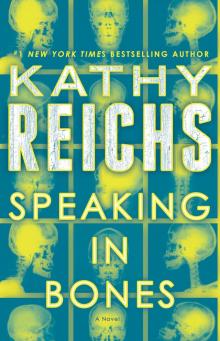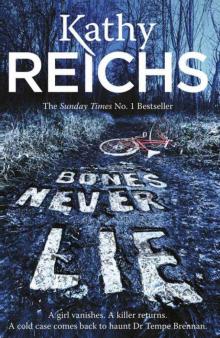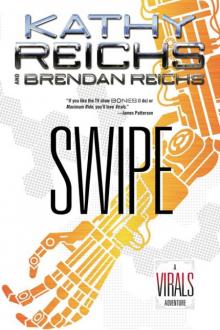- Home
- Kathy Reichs
Cross Bones Page 9
Cross Bones Read online
Page 9
“Christ and his followers at Judaism’s most sacred site.”
“You’ve got it. The possibility rocked Lerner’s world.”
“Would have rocked Israel, too, not to mention all of Christendom. What did Lerner do?”
“Major angst. What if it was Jesus? What if it wasn’t Jesus, but someone else of importance in the fledgling Christian movement? What if the bones fell into the wrong hands? What if the press got wind of the story? The sanctity of Masada would be disturbed. The Christian world would be enraged over what was sure to be labeled a Jewish hoax. Night after night he agonized.
“After weeks of mental torment, Lerner decided the skeleton had to go. He spent days planning ways to snatch and destroy it. He considered burning the bones. Smashing them with hammers. Weighting them and dropping them into the sea.
“Then his conscience would flip. Theft is theft. If the skeleton was Jesus he was still a Jew and a holy man. Lerner hardly slept. In the end, he couldn’t bring himself to destroy the skeleton, but he couldn’t live with the thought someone else might find it. To preserve religious culture and tradition, he resolved the skeleton had to disappear.”
“Lerner trashed the file and stole the bones.”
“Smuggled them out of the museum in an athletic bag.”
“And?” I sat up.
Birdie jumped to the floor, turned, and fixed me with round yellow eyes.
“That’s the throat-grabber. What’s the name of your gunshot victim?”
“Avram Ferris.”
“That’s what I thought.” Jake’s next words jolted me like a bottle rocket. “Lerner gave the bones and the photo to Avram Ferris.”
“His boyhood buddy,” I breathed.
“Ferris had spent two years kibbutzing in Israel, and was passing through Paris on his way back to Montreal.”
“Sonovabitch.”
“Sonovabitch.”
When we disconnected I tried Ryan. No answer. The heart-thumping surveillance had probably begun.
Too agitated to eat, I headed for the gym. Questions looped through my head as I pounded out flight after flight on the StairMaster. I tried arranging them into a logical progression.
Did Kessler’s photo really show the missing Masada skeleton?
If so, did Ferris have the Masada skeleton when he was killed?
Who else knew he had it?
Was Ferris planning to sell the skeleton on the black market? To whom? Why now?
Or was he perhaps offering to destroy it for a price? To be paid by whom? Jews? Christians?
If not, why was Ferris shot?
Where was the skeleton now?
Where was Kessler?
Who was Kessler?
Why would Ferris accept a stolen skeleton?
I could conjure some possibilities for that one. Loyalty to a friend? Shared concern about the disturbance of the sanctity of the Masada legend or fear over a colossal Jewish-Christian theological confrontation at a time when Western Christian support was essential to the preservation of Israel? Dora said her son was quite pious back then. Jesus living after the crucifixion and dying during the siege of Masada? It would have been a nightmare for Christians and Jews alike.
Or would it? Jesus was a Jew. Why shouldn’t he or his followers have been at Masada?
No. Jesus was a heretic Jew. He outraged the high priests.
Back to questions.
What would Ferris have done with the bones?
The logical repository would have been his warehouse.
SIJ had found no bones.
Might he have concealed them in such a way that a search would never turn them up?
I made mental notes. Ask Ryan. Ask Courtney Purviance.
Wiping sweat from my face, I pumped on.
Something was wrong with the warehouse idea.
The Torah forbids leaving a body unburied overnight. Deuteronomy or someone. Wouldn’t Ferris have felt polluted having human remains in his work area? At least uncomfortable? I moved from the Stair-Master to the bench press machine.
Maybe Ferris was only a transporter. Maybe he gave the bones to someone else.
To who?
Whom?
Someone who shared his and Lerner’s concern?
But any Jew would be bound by the Torah prohibition.
Someone with other reasons for wanting the skeleton to disappear?
Christian reasons?
If Jesus didn’t die on the cross, if Jesus lived, and his bones ended up in the Musée de l’Homme, such a finding would rock the Vatican and all of Protestant Christianity as well. The suggestion would have to be absolutely refuted, or it would blow the most basic tenet of the Christian faith right out of the water. No empty tomb. No angels. No resurrection. No Easter. The investigation and the controversy would be headline news around the globe for months. Years. The debate would be unprecedented. The passion and acrimony would be devastating.
I stopped in midpump.
The third friend! The priest from the Beauce!
Dora said the two men were very close.
Priests have no hang-ups with human bones. They wear them as relics. Embed them in altars. Display them in churches all over Europe.
Suddenly, I was in a froth to locate that priest.
I looked at my watch. Six-thirty. Grabbing my towel, I headed for the locker room.
My cell phone was barely registering a pulse. Throwing on sweats and my jacket, I hurried outside.
Jake answered after four rings, voice thick with sleep.
As I walked along Ste-Catherine, I explained about Ferris, Lerner, and the priest.
“I need a name, Jake.”
“It’s after midnight here.”
“Doesn’t Lerner work at night?”
“Okay.”
I heard a yawn.
“And anything else you can find out about this priest. Was he involved in the theft of the skeleton? Where was he living back in seventy-three? Where is he living now?”
“Boxers or briefs?”
“That kind of thing.”
“Calling this late might tick Lerner off.”
“I have confidence in your persuasive abilities.”
“And my boyish charm.”
“And that.”
I was stepping out of my shower when the phone rang.
Wrapping myself in a towel, I did a slip-’n’-slide across the tile, bolted to my bedroom, and grabbed the handset.
“Sylvain Morissonneau.”
“You’re a rock star,” I said, jotting the name on the back of a bank statement.
“You have me confused with Sting,” Jake said.
“Was Morissonneau involved in the skeleton heist?”
“No.”
“Where is he now?”
“Lerner never knew Morissonneau all that well. Says he left for Paris shortly after the other two met at Yeshiva. Hasn’t seen or heard from Morissonneau since seventy-one.”
“Oh.”
“I did learn one thing.”
I waited.
“Morissonneau’s a Cistercian.”
“A Trappist monk?”
“If you say so.”
After a defrosted dinner of Thai chicken and rice, I booted my computer and began a Web search.
Charlie kept squawking “Get Off of My Cloud.” Birdie purred on the desk to my right.
In the course of my research, I learned several things.
In 1098 C.E., a renewal movement began within Benedictine monasticism, at the monastery of Cîteaux, in central France. The idea was to restore, as far as possible, the literal observance of the Rule of Saint Benedict. I never learned what that meant.
The Latin word for Cîteaux is Cistercium, and those who signed on to the reform movement came to be known as Cistercians.
Today there are several orders within the Cistercians, one of which is the OCSO, Cistercian Order of the Strict Observance. Trappist, the nickname for the OCSO, came from another reform movement at an
other French monastery, La Trappe, in the seventeenth century.
Lots of reform movements. Makes sense, I guess. Monks have a lot of time to reflect and decide to do better.
I found three Cistercian monasteries in Quebec. One in Oka, near Lac des Deux-Montagnes, One at Mistassini, near Lac Saint-Jean. One in the Montérégie region, near Saint-Hyacinthe. Each had a website.
I spent two hours working through endless cyberloops explaining the monastic day, the spiritual journey, the meaning of vocation, the history of the order. Search as I might, I found no membership listing for any of the monasteries.
I was about to give up when I stumbled on a brief announcement.
On July 17, 2004, the monks of l’Abbaye Sainte-Marie-des-Neiges, with Fr. Charles Turgeon, OCSO presiding, chose their eighth abbot, Fr. Sylvain Morissonneau, 59. Born in Beauce County, Quebec, Fr. Morissonneau attended university at Laval. He was ordained a priest in 1968, then pursued academic studies in the United States. Fr. Morissonneau entered the abbey in 1971. For eight years prior to his election, he served as the monastery’s business manager. He brings to the office skills both practical and academic.
So Morissonneau had stuck with the contemplative life, I thought, clicking from the monastery’s website to MapQuest Canada.
Sorry, Father. Your solitude’s about to be busted.
11
THE MONTÉRÉGIE IS AN AGRICULTURAL BELT lying between Montreal and the U.S. border. Composed of hills and valleys, crisscrossed by the rivière Richelieu, and outlined by the banks of the fleuve Saint-Laurent, the region is lousy with parks and green space. Parc national des Îles-de-Boucherville. Parc national du Mont-Saint-Bruno. Le Centre de la Nature du Mont Saint-Hilaire. Tourists visit the Montérégie for nature, produce, cycling, skiing, and golf.
L’Abbaye Sainte-Marie-des-Neiges was located on the banks of la rivière Yamaska, north of the town of Saint-Hyacinthe, in the center of a trapezoid formed by Saint-Simon, Saint-Hugues, Saint-Jude, and Saint-Barnabe-Sud.
The Montérégie is also lousy with saints.
At nine-twenty the next morning, I turned from the two-lane onto a smaller paved road that wound through apple orchards for approximately a half mile, then made a sharp turn and cut through a high stone wall. A discreet plaque indicated I’d found the monks.
The monastery sprawled beyond an expanse of open lawn, and was shaded by enormous elms. Constructed of Quebec gray stone, the place looked like a church with metastatic disease. Wings shot from three sides, and subsidiary winglets shot from the wings. A four-story round tower stood at the junction of the easternmost wing and the church proper, and an ornate square spire shot from its westernmost counterpart. Some windows were arched. Others were square and shuttered. Several outbuildings lay between the main structure and the cornfields and river at its back.
I took a moment to assess.
From my cybertour I’d learned that many monks make concessions to economic necessity, producing and selling baked goods, cheese, chocolate, wine, veggies, or items of piety. Some host visitors seeking spiritual rejuvenation.
These boys didn’t appear to be of that mind-set. I saw no welcoming shingle. No gift shop. Not a single parked car.
I pulled to the front of the building. No one appeared to greet or challenge me.
My time on the Web had also taught me that the monks of Sainte-Marie-des-Neiges rise at 4 A.M., observe multiple rounds of prayer, then labor from eight until noon. I’d planned my visit to coincide with the morning work period.
In February that didn’t involve apples or corn. Other than sparrows and ground squirrels, there wasn’t a sign of life.
I got out and softly clicked the car door shut. Something about the place demanded quiet. An orange door to the right of the round tower looked like my best bet. I was walking in that direction when a monk rounded the far end of the spire wing. He wore a brown hooded cape, socks, and sandals.
The monk didn’t stop when he saw me, but continued more slowly in my direction, as though giving himself time to consider the encounter.
He halted three yards from me. He’d been injured at some point. The left side of his face looked slack, his left eyelid drooped, and a white line diagonaled that cheek.
The monk looked at me but didn’t speak. He had hair mowed to his scalp, sharpness to his chin, and a face gaunt as a musculoskeletal diagram.
“I’m Dr. Temperance Brennan,” I said. “I’m here to speak with Sylvain Morissonneau.”
Nothing.
“It’s a matter of some urgency.”
More nothing.
I flashed my LSJML identity card.
The monk glanced at the ID but held his ground.
I’d anticipated a cool reception. Reaching into my shoulder bag, I withdrew a sealed envelope containing a photocopy of Kessler’s print, stepped forward, and held it out.
“Please give this to Father Morissonneau. I’m certain he’ll see me.”
A scarecrow hand snaked from the robe, snatched the envelope, then signaled that I should follow.
The monk led me through the orange door, across a small vestibule, and down a lavishly paneled hall. The air smelled like Monday mornings in the parochial schools of my youth. A mélange of wet wool, disinfectant, and wood polish.
Entering a library, my host gestured that I should sit. A flattened palm indicated that I should stay.
When the monk had gone I surveyed my surroundings.
The library looked like a set transported from a Harry Potter movie. Dark paneling, leaded-glass cabinets, rolling ladders going up to third-story shelves. Enough wood had been used to deforest British Columbia.
I counted eight long tables and twelve card catalogs with tiny brass handles on the drawers. Not a computer in sight.
I didn’t hear the second monk enter. He was just there.
“Dr. Brennan?”
I stood.
This monk was wearing a white cassock and a brown overgarment made up of rectangular front and back panels. No cape.
“I am Father Sylvain Morissonneau, abbot of this community.”
“I’m sorry to come unannounced.” I held out my hand.
Morissonneau smiled but kept his hands tucked. He looked older, but better-fed than the first monk.
“You are with the police?”
“The medical-legal lab in Montreal.”
“Please.” Morissonneau made a hand gesture identical to that of his colleague. “Follow me.” English, with a heavy québécois accent.
Morissonneau led me back down the main corridor, across a large open space, then into a long, narrow hall. After passing a dozen closed doors, we entered what appeared to be an office.
Morissonneau closed the door, and gestured again.
I sat.
Compared with the library, this room was spartan. White walls. Gray tile floor. Plain oak desk. Standard metal file cabinets. The only adornments were a crucifix behind the desk, and a painting above one row of cabinets. Jesus talking to angels. And looking considerably more fit than in the carved wooden version hanging over the desk.
I glanced from the canvas to the cross. A phrase popped into my head. Before and after. The thought made me feel sacrilegious.
Morissonneau took the straight-back desk chair, laid my photocopy on the blotter, laced his fingers, and looked at me.
I waited.
He waited.
I waited some more.
I won.
“I assume you have seen Avram Ferris.” Low and even.
“I have.”
“Avram sent you to me?”
Morissonneau didn’t know.
“No.”
“What is it Avram wants?”
I took a deep breath. I hated what I had to do.
“I’m sorry to be the bearer of bad news, Father. Avram Ferris was murdered two weeks ago.”
Morissonneau’s lips formed some silent prayer, and his eyes dropped to his hands. When he looked up his face was clouded with an
expression I’d seen too often.
“Who?”
“The police are investigating.”
Morrissonneau leaned forward onto the desk.
“Are there leads?”
I pointed at the photocopy.
“That photo was given to me by a man named Kessler,” I said.
No reaction.
“Are you acquainted with Mr. Kessler?”
“Can you describe this gentleman?”
I did.
“Sorry.” Morissonneau’s eyes had gone neutral behind his gold-rimmed glasses. “That description fits many.”
“Many who would have access to this photo?”
Morissonneau ignored this. “How is it you come to me?”
“I got your name from Yossi Lerner.” Close enough.
“How is Yossi?”
“Good.”
I told Morissonneau what Kessler had said about the photo.
“I see.” He arched his fingers and tapped them on the blotter. For a moment his focus shifted to the photocopy, then to the painting to my right.
“Avram Ferris was shot in the back of the head, execution style.”
“Enough.” Morissonneau rose. “Please wait.” He gave me the palm-stay gesture. I was beginning to feel like Lassie.
Morissonneau hurried from the room.
Five minutes passed.
A clock bonged somewhere down the hall. Otherwise, the building was silent.
Ten minutes passed.
Bored, I rose and crossed to examine the painting. I’d been right but wrong. The canvas and crucifix did constitute a before-and-after sequence, but I’d reversed the order.
The painting depicted Easter morning. Four figures were framed by a tomb. Two angels sat on an open stone coffin, and a woman, probably Mary Magdalene, stood between them. A risen Jesus was to the right.
As in the library, I didn’t hear Morissonneau’s entry. The first thing I knew he was circling me, a two-by-three-foot crate in his hands. He stopped when he saw me, and his face softened.
“Lovely, isn’t it? So much more delicate than most renderings of the resurrection.” Morissonneau’s voice was altogether different than it had been earlier. He sounded like Gramps showing photos of the grandkids.

 Two Nights
Two Nights The Bone Collection: Four Novellas
The Bone Collection: Four Novellas Fatal Voyage
Fatal Voyage 206 Bones
206 Bones Bones to Ashes
Bones to Ashes Terminal
Terminal Monday Mourning
Monday Mourning Flash and Bones
Flash and Bones Cross Bones
Cross Bones Devil Bones
Devil Bones Break No Bones
Break No Bones Swamp Bones
Swamp Bones Déjà Dead
Déjà Dead Shock
Shock Spider Bones
Spider Bones Death Du Jour
Death Du Jour Grave Secrets
Grave Secrets Trace Evidence: A Virals Short Story Collection
Trace Evidence: A Virals Short Story Collection Bones on Ice
Bones on Ice The Bone Code
The Bone Code Bones in Her Pocket
Bones in Her Pocket Seizure:
Seizure: Speaking in Bones
Speaking in Bones Deadly Decisions
Deadly Decisions Spike
Spike Bones Never Lie
Bones Never Lie Bones of the Lost
Bones of the Lost Virals 03.5 - Swipe
Virals 03.5 - Swipe Exposure
Exposure A Conspiracy of Bones
A Conspiracy of Bones Shift (tory brennan)
Shift (tory brennan) Bones of the Lost: A Temperance Brennan Novel tb-16
Bones of the Lost: A Temperance Brennan Novel tb-16 Virals tb-1
Virals tb-1 Bones Are Forever tb-15
Bones Are Forever tb-15 Code tb-3
Code tb-3 Seizure tb-2
Seizure tb-2 Deadly Descisions
Deadly Descisions Spider Bones: A Novel
Spider Bones: A Novel